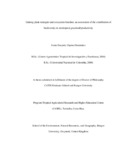Mostrar el registro sencillo del ítem
Linking plant strategies and ecosystem function: an assessment of the contribution of biodiversity to neotropical grassland productivity
| dc.contributor.author | Ospina Hernández, Sonia Daryuby | es_ES |
| dc.date.accessioned | 2015-11-18T06:16:23Z | |
| dc.date.available | 2015-11-18T06:16:23Z | |
| dc.date.issued | 2013-06-03 | es_ES |
| dc.identifier.uri | https://repositorio.catie.ac.cr/handle/11554/8015 | |
| dc.description | Thesis (Ph.D.) | es |
| dc.description.abstract | To understand the diversity of strategies of resource use at the species and community level of co-existing species in semi-natural grasslands, I used three different approaches: a) the comparison of above-ground net primary productivity (ANPP) in semi-natural grasslands and sown pastures common to silvopastoral systems in Central Nicaragua and their relationships with rainfall seasonality; b) quantitative ordination of a set of primary foliar traits and another set of traits with less well-documented evidence about their correspondence with the trade-off between resource acquisition and conservation, across various life histories and life forms; c) the determination of community weighted means of plant traits following seasonal shifts in species relative cover, over a year. These issues were investigated in a range of paddocks with two types of cover: semi-natural grassland and sown pastures within an altitudinal range of 200 to 400 m. In nine paddocks, 11 sequential biomass harvests after 22-day periods of grazing exclusion were conducted approximately every month for each paddock. In eight different paddocks 14 morpho-phenological traits were measured in the 36 dominant species. This information was complemented with: i) species cover estimations from five different cover plots in 1 x 1 m2 quadrats, located in each of these areas during the period July 2nd 2007 and May 26th 2008, totalling 440 records; ii) soil chemical and physical properties; iii) daily rainfall data. The main axis of species differentiation was identified based on primary or key foliar traits, which provided evidence of a predominant resource economy axis in these grasslands, and a second axis which differentiated life-history and life forms among species. The aggregated morpho-phenological traits showed that the dominance of plants with high foliar concentrations of P, N, Ca, K and Mg, high specific leaf area, long lateral spread by clonal growth, low leaf dry matter content and short leaf lifespan increased in the rainy season and declined towards the dry season. These results suggested the relevance of rainfall seasonality to community functional properties in these grassland assemblages and that species shift their dominance according to the general species level trade-offs between resource acquisition and conservation, in this case based on the seasonal gradient of water and, indirectly, resource supply. There were no differences in annual ANPP between sown pastures and grasslands with both sown pastures and grasslands having low productivity in the late dry season. In contrast, the temporal stability of ANPP was higher in semi-natural grasslands than in sown pastures. Overall, I interpreted that the gains of replacing grasslands with sown pastures are questionable, and need to be weighed against increased costs and the ecological and environmental risks of reducing the diversity of these grasslands. | es |
| dc.description.sponsorship | CATIE (Tropical Agricultural Research and Higher Education Centre) ; Bangor University | es |
| dc.language.iso | en | es |
| dc.relation.ispartof | Programa Agroambiental Mesoamericano (MAP). Fase I | |
| dc.subject | PASPALUM | es |
| dc.subject | BRACHIARIA BRIZANTHA | es |
| dc.subject | TIERRAS DE PASTOS | es |
| dc.subject | PRADERAS | es |
| dc.subject | BIODIVERSIDAD | es |
| dc.subject | ECOSISTEMA | es |
| dc.subject | COMPOSICION BOTANICA | es |
| dc.subject | ESTACION HUMEDA | es |
| dc.subject | NICARAGUA | es |
| dc.title | Linking plant strategies and ecosystem function: an assessment of the contribution of biodiversity to neotropical grassland productivity | es |
| dc.type | Tesis | es_ES |
Ficheros en el ítem
Este ítem aparece en la(s) siguiente(s) colección(ones)
-
Publicaciones y documentos [3628]


